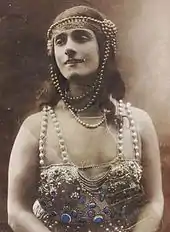Mârouf, savetier du Caire
Mârouf, savetier du Caire (Marouf, Cobbler of Cairo) is an opéra comique by the French composer Henri Rabaud. The libretto, by Lucien Nepoty, is based on a tale from the Arabian Nights. Mârouf was first performed at the Opéra-Comique, Paris, on 15 May 1914. The premiere was a great success and Mârouf became Rabaud's most popular opera. The score makes great use of oriental colour. The United States premiere of the opera was given at the Metropolitan Opera on December 19, 1917, with Giuseppe De Luca in the title role, Frances Alda as Princess Saamcheddine, and Pierre Monteux conducting. The Viennese premiere was at the Vienna State Opera on 24 January 1929, with Josef Kalenberg and Margit Angerer ("who received the most applause"[1]), and Franz Schalk conducting.[2]
The opera was revived at the Opéra-Comique in 2013 in a production by Jérôme Deschamps, with Jean-Sébastien Bou in the title role, conducted by Alain Altinoglu.[3]
Roles

| Role | Voice type | Premiere cast, 15 May 1914 Conductor: François Ruhlmann |
|---|---|---|
| Mârouf | baritone | Jean Périer |
| Fattoumah, his wife | soprano | Jeanne Tiphaine |
| The Sultan of Khaïtân | bass | Félix Vieuille |
| Princess Saamcheddine, his daughter | soprano | Marthe Davelli |
| His vizier | bass | Jean Delvoye |
| Ali | bass | Daniel Vigneau |
| Fellah/Genie | tenor | Georges-Louis Mesmaecker |
| First merchant | tenor | Maurice Cazeneuve |
| Second merchant | tenor | Éric Audoin |
| First policeman | tenor | Pierre Delager |
| Second policeman | baritone | Corbière |
| Chief sailor/First muezzin | tenor | Eugène de Creus |
| Second muezzin | bass | Thibault |
| Donkey-driver | tenor | Donval |
| First mamluk | baritone | Jean Reymond |
| Second mamluk | bass | Brun |
| Pâtissier/Ahmed | bass | Louis Azéma |
| Kadı | bass | Paul Payen |
| ballerinas | silent | Sonia Pavloff, Germaine Dugué, Gina Luparia, Sallandri |
| ballerino | silent | Robert Quinault |
Synopsis
The hen-pecked cobbler Mârouf decides to join a group of sailors and travels to Khaïtân where he pretends to be a rich merchant awaiting the arrival of his caravan. The sultan is impressed and offers him the hand of his daughter Saamcheddine. Mârouf's deception is discovered and he flees, followed by the princess, who has fallen in love with him. They find a mysterious ring which gives Mârouf power over a magician. The magician grants Mârouf's wish for the caravan he boasted about to become reality. The sultan is appeased, pardons Mârouf and allows him to marry Saamcheddine.
References
- 1929 review by Soma Morgenstern, republished in Kritiken, Morgenstern, 2001
- Online archive of the Vienna State Opera, accessed 29 July 2021
- Francis Carlin, review of Mârouf, savetier du Caire, Opéra Comique, Paris. Financial Times, 27 May 2013.
Sources
- The Viking Opera Guide, ed. Holden (Viking, 1993)
- Del Teatro (in Italian)
- Casaglia, Gherardo (2005)."Mârouf, 15 May 1914". L'Almanacco di Gherardo Casaglia (in Italian).
- Mârouf, savetier du Caire: Scores at the International Music Score Library Project